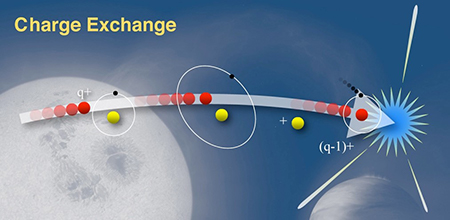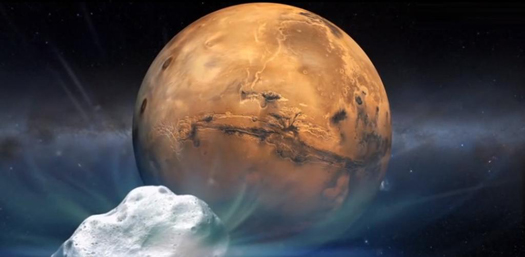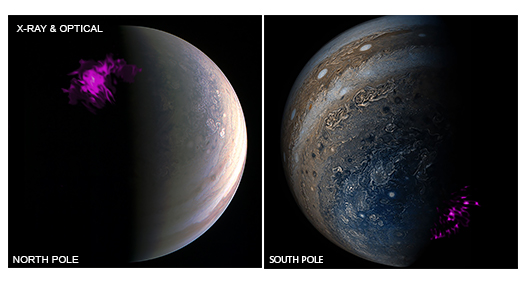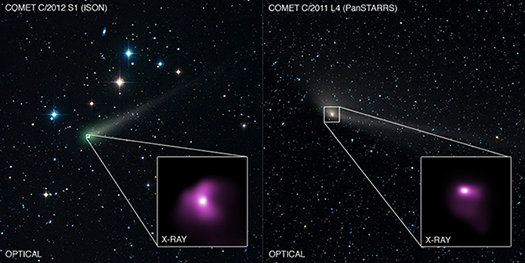Solar System
What We Found When We X-rayed Uranus

Affelia Wibisono
We are pleased to welcome Affelia Wibisono, who received her Masters degree in Physics from Royal Holloway, University of London in 2012, as our guest blogger. She worked as a science communicator at London’s Science Museum and the Royal Observatory Greenwich before starting her PhD in 2018 at University College London’s Mullard Space Science Laboratory (MSSL). Her research interests are in X-ray emissions from planets in our Solar System, in particular how and why Jupiter produces intense X-ray auroras.
Huge, violent and exotic objects in space such as black holes, supernovae and quasars are what usually come to mind when one thinks about X-ray astronomy. But it’s the more humble X-ray sources found closer to home that my research group and I want to know more about. Many things in our Solar System emit X-rays, such as the Sun, comets, moons and even Pluto. Astronomers have also detected X-rays from the four rocky planets, Mercury, Venus, Earth and Mars, and from the gas giants Jupiter, and Saturn. However, efforts to find X-rays from Uranus in 2002 and 2017 were fruitless — or so we thought.
Studying Comet 46P/Wirtanen During its Close-by Visit Near Earth

Dennis Bodewits in Japan during the
‘Comets, Meteors, and Asteroids’ conference.
We welcome Dennis Bodewits as a guest blogger. Dennis studies the chemical and physical behavior of comets. He is an associate professor at Auburn University in Auburn, Alabama, and leads a large observing campaign combining multiple NASA spacecraft to study comet 46P/Wirtanen during its close-by visit near Earth. He loves the outdoors, mountain biking in Auburn's Chewacla State Park, and has piloted a human-powered helicopter.
I got into comet research while conducting experiments at the University of Groningen in the Netherlands. My work supported fusion — where two lighter nuclei join to create heavier ones — research. To measure the temperature in fusion plasmas, you can't just stick a thermometer in your reactor. Instead, the idea was to let in a little bit of trace gas which would make the ions, that is, atoms that have a positive charge, glow.
It turned out that the main reaction responsible for this light, charge exchange, had been discovered in comets. Charge exchange is the process where a charged ion collides with a neutral atom or molecule and captures one of its electrons. Light is then emitted as the captured electron moves to a lower energy state. This process is especially important in comets where ions from the solar wind collide with neutral atoms in cometary atmospheres. For my doctorate I worked on trying to find out what I could learn about comets and the solar wind from charge exchange emission, combining lab work with Chandra observations.

The Dynamic Duo: Jupiter's Independently Pulsating X-ray Auroras
Jupiter's intense northern and southern lights, or auroras, behave independently of each other according to a new study using NASA's Chandra X-ray and ESA's XMM-Newton observatories.
Chandra Detects the First X-rays Coming From Our Kuiper Belt

Carey Lisse (left) and Ralph McNutt Jr. (right)
We are pleased to welcome a pair of distinguished guests to the Chandra blog. Carey Lisse is currently a principal staff scientist at Johns Hopkins University Applied Physics Laboratory (JHU-APL). He has used ACE, Chandra, EUVE, HST, ROSAT, Spitzer, and XMM-Newton as well as numerous ground based telescopes to study the physical properties of many Solar System objects. Ralph McNutt Jr. is a physicist also at JHU-APL. Among his many other positions, he serves as the co-investigator for the PEPSSI instrument aboard New Horizons. He also been the principal investigator on many other spacecraft and experiments designed to explore the Solar System and beyond. Lisse and McNutt are the 1st and 2nd authors of a paper that is the basis for our latest press release, about the surprising Chandra detection of Pluto.
Once the stuff of science fiction when we were kids, the fantastically successful NASA New Horizons mission's flyby of Pluto in July 2015 has transformed our understanding of Pluto from a point-like object into a fascinating world. It has also inspired a plethora of new observations of the system to take advantage of the once-in-a-lifetime flyby event. We ran one of these sets of observations using NASA's Chandra X-ray Observatory. Launched in 1999, Chandra is now one of the established premier observatories of our time - in fact it is one of NASA's four Great Observatories (along with the Hubble Space Telescope, Spitzer Space Telescope, and the Compton Gamma Ray Observatory ).
X-ray Detection Sheds New Light on Pluto
The first detection of Pluto in X-rays has been made using NASA's Chandra X-ray Observatory in conjunction with observations from NASA's New Horizon spacecraft. As reported in our press release this result offers new insight into the environment surrounding the largest and best-known object in the solar system's outermost regions.
Comets in the "X"-Treme
For millennia, people on Earth have watched comets in the sky. Many ancient cultures saw comets as the harbingers of doom, but today scientists know that comets are really frozen balls of dust, gas, and rock and may have been responsible for delivering water to planets like Earth billions of years ago.
Jupiter: Solar Storms Ignite 'Northern Lights' on Jupiter
Solar storms are triggering X-ray auroras on Jupiter that are about eight times brighter than normal over a large area of the planet and hundreds of times more energetic than Earth's 'northern lights,' according to a new study using data from NASA's Chandra X-ray Observatory. This result is the first time that Jupiter's auroras have been studied in X-ray light when a giant solar storm arrived at the planet.
Chandra Awaits Comet Siding Spring's Approach to Mars
On October 19th, Chandra will join with telescopes across the world, in orbit around Earth, and even on and around Mars, as Comet Siding Spring makes an extremely close approach to the Red Planet.

This is an extremely exciting event because scientists have determined this comet has been traveling for maybe a million years from the distant Oort Cloud. This will be the first time that humans have ever captured images of a comet from the Oort Cloud, which is an enormous reservoir of left over debris from the formation of the Solar System. (Previous observations and spacecraft visits of comets came from those that originated in the much closer Kuiper Belt.)
Close Planetary Pair and Chandra
All this week, Venus and Jupiter have appeared very close to each other in the night sky. Most people in the Northern Hemisphere have been able to spot the planetary duo in the western skies about four hours after sunset.
This close pairing is a nice treat for skywatchers on Earth, but it really is an optical illusion of sorts. The planets are, of course, nowhere near each other. Venus is about 75 million miles away in one direction and Jupiter is over 500 million miles away in the other. Venus and Jupiter simply appear to come close to another from our vantage point on Earth as they travel in their usual orbits around the Sun.
Chandra and the Latest Giant Solar Flare
On Friday March 2, 2012, we noticed Sunspot Group 1429 moving onto the Earth facing part of the Sun. The NOAA space weather service informed us that the magnetic topology was complex and this was a cell to watch out for. Sure enough, on Sunday night (March 4, Eastern time) the Sun emitted a short X1 flare. We all felt a bit better, because this often will relax the magnetic field. And since it was well off on the Eastern limb of the Sun, any coronal mass ejection (CME) should have missed us.






